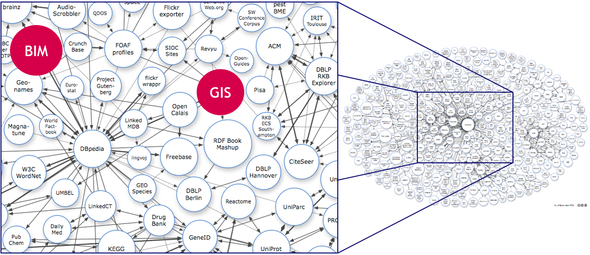i-KNOW workshop “Building Knowledge”
Web of Data meets Building, Architecture and Urban Modelling
Full-day workshop at i-KNOW 2014 September 16, 2014
For the updated schedule and further information please see this evolving document
Presentations available here.
For more information on the i-KNOW conference please go to http://i-know.tugraz.at/
Please send us a mail for more information and hopefully signal your interest to participate. A separate invitation and call for proposals and short papers will follow soon.
Apart from the enriched data sets themselves, a joint publication of this experimental workshop form is intended as a tangible results.
Introduction
The Web of Data has emerged as an unprecedented resource for knowledge and structured data in all sorts of domains. While the building, architecture and urban planning fields are fundamentally reliant on data which document the structure, context or evolution of structures and their environment, an increasing amount of contextual information about buildings, their geo-location, history, legal context, the surrounding infrastructure or the usage and perception of structures by the general public has become available on the Web. Examples include in particular the wide range of Linked Data about geo-data (e.g. Geonames), building-related policies (e.g. GBPN) or traffic statistics (for instance as part of data.gov.uk) as well as the wide range of information which can be extracted from social media, for instance, as indicators of public perception and usage of structures and environments.
The growing need of information integration across domains of the built environment (geographic information | civil engineering | urban planning | buildings | building components | sustainable city developments | archicture etc.) has led to a recent spike of initiatives, (EU and national ­funded) research projects and standardization efforts that are using semantic web technologies to represent and transform these historically grown domain vocabularies.
Furthermore, over the course of several decennia, interoperability and standardization efforts in the field of Architecture, Engineering and Construction (AEC) has led to large panorama of expressive, well­documented and vendor­neutral data models, classification systems, taxonomies and other structured vocabularies. This has let to an abundance of datasets, vocabularies and schemas used in the fields of urban planning and building modelling, where vocabularies as well as datasets are largely disconnected and still isolated. Here established solutions from other domains, such as ontology matching, data mining, data fusion and entity linking, generic data visualization, offer potential solutions to address these issues.
With an integrated view on the information of our built environment, one is able to provide end users more easily with an overall understanding of his environment, allowing them to interact with it and interactively change it into a responsible smart city and smart building environment.
Examples of such models | vocabularies | classification and projects (many
available in RDF):
IFC, bSDD, INSPIRE, OGC Geo models, SfB(­NL), DIN 276(?), Omniclass, Uniclass, Getty AAT, BauDataWeb, CROW, OKSTRA, LandXML, CASCADE airport ontology, SIMmodel, GIS ontologies, CityGML, ETIM, gbXML etc.
Workshop schedule:
|
Time |
Topic |
Description |
Presenter/Responsible person |
|
8:30 |
Registration, get together |
please present printed copies of the Workshop registration ticket on the conference floor |
all |
|
9:00 |
Welcome |
Kick-off, Introduction among participants |
JB, all |
|
9:15 |
Workshop intro |
Aims and goals: creating new knowledge by making an inventory, repository and alignments among Intro to technical infrastructure Example alignment |
JB |
|
10:00 |
Ready4SmartCities catalogue
|
Introduction to repository. Top-level contents of catalogued vocabularies, future strategies |
|
|
10:30 |
Linking Strategies |
Dataset Profiling, Semantic Enrichment, Focussed Crawling, Relevance Assessment |
Ujwal Gadiraju |
|
11:00 |
Alignment server |
remote: Jerome Euzenat? |
|
|
11:30 |
Plenary session |
– use case inventory – requirements evolving from use cases – alignment strategies for vocabularies and datasets / instances |
all, moderated by:? |
|
12:30 |
lunch break |
Buffet in main hall |
all |
|
13:30 |
INSPIRE / CityGML |
Introduction to the model, mapping session |
Seppo
|
|
13:50 |
IfcOWL/RDF and SimModel |
Introduction to the model, mapping session |
Pieter Pauwels Edward Corry (remote) |
|
14:10 |
COINS, CityGML |
Introduction projects |
Leon van Berlo |
|
14:20 |
DIMMER |
Introduction to project |
|
|
14:30 |
Matthias Weise |
||
|
15:00 |
Plenary working session |
||
|
17:00 |
Closing session |
Conclusions, future steps |
all |
Workshop aims and scope
We propose an interactive workshop that provides a forum for researchers and practitioners from building and infrastructure-related areas as well as from fields such as data engineering, semantic web and knowledge modelling to share and discuss novel works in the field.
One of the intended outcomes of the workshop is the establishment of a common registry for datasets and vocabularies from the fields of building and construction in architecture and civil engineering, where mappings and links provide a more integrated view on the existing landscape. Instead of aiming
at a rigid axiomatic high­level pivot­ or upper­ ontology to which everything is mapped (á la
SUO/SUMO), a light¬≠weight approach using vocabularies with ‚Äėsofter‚Äô semantics such as SKOS
& DC will be pursued. This allows the rapid, ad hoc creation of many relations among concepts
without risking to invalidate intricate description logic models while staying faithful to the LOD
spirit that cherishes the emergence of synergetic effects by means of machine­readable
interrelations.
Workshop implementation approach
As a common platform/sandbox tool, the workshop will provide a quadstore database with
sufficient resources (RAM/disk) to which the workshop participants will be granted access (e.g.
via SPARQL endpoints). This will be initially populated with a number of different vocabulary
dumps from various disparate sub­domains in building and civil engineering (architecture,
building materials, roads, tunnels, bridges, pipes etc.) as well as modeling and standardization
initiatives on national and international levels. Each workshop participant will be asked to take
responsibility for one vocabulary she/he is familiar with or has gotten acquainted with in
preparation for the workshop. Using software tools such as editors, profilers, mappers etc. freely
to be chosen by the workshop participants (or suggested by the organizers) relations among
vocabularies¬†will¬†be¬†created¬†during¬†the¬†workshop.¬†Next¬†to¬†these¬†‚Äėtraditional‚Äô¬†digital¬†tools¬†(which
could also be effectively used in the solitary confinement of isolated laboratory settings) we
strongly encourage the use of analogue but highly interactive tools such as whiteboards,
flipcharts and post­it notes to leverage the advantages of co­located synchronous collaboration
settings. The results of these efforts will be immediately concurrently stored (or populated in a
post­processing session) in separate yet open contexts | named graphs | reification clusters
which will reside on the same machine. As a result of the workshop, the individual vocabularies
and created relations will be exposed on the provided data store and can be physically taken
home as a dump on USB sticks by the participants.
The ‚Äėwork‚Äô in workshop
Each workshop participant will give a short, high­level introduction to the vocabulary at hand,
ideally following a suggested template prepared by the chairs For this template, we initialy
suggest¬†a¬†breadth¬≠first¬†approach¬†that¬†starts¬†at¬†the¬†high¬≠level¬†e.g.¬†‚Äúmy¬†top¬†object¬†is¬†‚ÄėIfcRoot‚Äô,
‚ÄėObject‚Äô,¬†‚ÄėThing‚Äô‚Ä̬†‚ÄúMy¬†vocabulary¬†has¬†a¬†‚Äėpart¬≠of‚Äô¬†relation‚Ä̬†.¬†Each¬†presentation¬†will¬†periodically¬†be
intervened by sequential bursts of activity by the participants to allow the creation of relations in a
vocabulary/context of choice (VoL, VoID, plain SKOS/DC/RDF/OWL etc). Individual vocabulary
sessions should not exceed 20 min depending on the number of participants / vocabulary
sessions. Following these initial vocabulary sessions, small groups (2 to 3 people) start mapping
or linking a chosen number of vocabularies and make sure that the resulting combined
vocabulary can be communicated (via an interface with a graphical 3D representation of the 3D
model).¬†These¬†groups¬†are¬†formed¬†in¬†a¬†‚Äėspeed¬†dating‚Äô¬†programme,¬†forcing¬†people¬†to¬†collaborate
and produce an end result after 20 minutes.
­
Organisers:
- Jakob Beetz is an assistant professor at the Design Systems group of the Department of the Built Environment at the Eindhoven University of Technology. His research areas include Buidling Information Modeling and Semantic Web technologies.
- Pieter Pauwels is a postdoctoral researcher at the Department of Architecture and Urban Planning, Ghent University. He investigates how and to what extent information system support can be provided to experts in architecture and construction, thereby focusing on Building Information Modelling (BIM) and semantic web technologies.
- ­Matthias Weise is head of the software development department of AEC3,  an international consulting company in the field of process optimisation in the building industry. AEC3 is frequently acting on behalf of the buildingSMART organization, the predominant standardization body in the AEC/FM field
- ­ Seppo Törmä is a researcher at the Distributed Systems Group of the Department of Computer Science and Engineering at Aalto University. His fields of research include complex event processing, linked data and cognitive collaboration.
- ­ Stefan Dietze is a research group leader at the L3S Research Center of the Leibniz University Hanover, Germany, where he is dealing with research in the fields of semantic & social web, knowledge­based systems and context adaptation with a focus on the use of semantic technologies for data and service integration



Leave a Reply